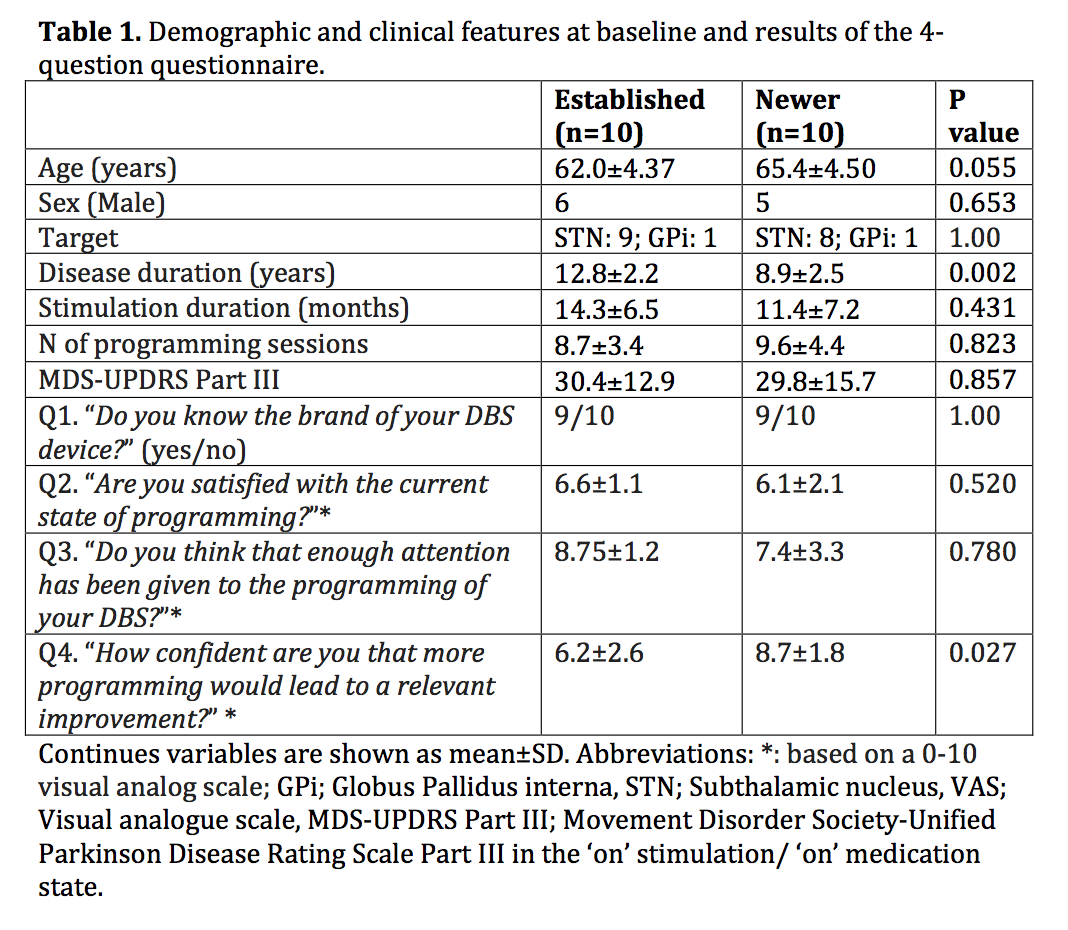Session Information
Date: Wednesday, September 25, 2019
Session Title: Surgical Therapy
Session Time: 1:15pm-2:45pm
Location: Les Muses Terrace, Level 3
Objective: To assess the subjective experience/expectations of Parkinson’s disease(PD) patients who have undergone deep brain stimulation(DBS) using either an established(Medtronic, Minneapolis, MN, USA) or newer system with additional capabilities(Boston Scientific, Marlborough, MA, USA).
Background: The Medtronic system(3387 electrode, Activa implantable pulse generator) is commonly used for DBS in the treatment of PD.1 Newer systems have been more recently released and can provide additional versatility(e.g. directionality, multiple frequency, short pulse width).2 There has been no formal comparison between these systems, particularly in respect to patients’ experience/expectations.
Method: We provided a 4-question questionnaire to 20 consecutive PD patients on either ‘established’ or ‘newer’ system(10 patients each). Inclusion criteria: bilateral targeting of subthalamus or Globus Pallidus pars interna, absent uncontrolled psychiatric disorders, follow-up duration 6 to 24 months post DBS. Statistical analysis was performed using independent t-test(normally distributed) and Mann–Whitney U test(not normally distributed values) using SPSS software.
Results: There was no significant between-group difference in demographic and clinical variables with the exception of disease duration. This was significantly shorter in patients receiving the ‘newer’ system(Table 1). One patient in each group was unable to identify the brand of their system. There was no significant between-group difference when asked about satisfaction level of current state of programming and if enough attention was given to programming(Table 1). There was significant higher confidence that further programming could lead to clinical improvement(8.7±1.8 vs. 6.2±2.6, ‘newer’ vs. ‘established’ systems respectively, p =0.027).
Conclusion: In this small sample cross-sectional questionnaire-based study, we found that patients treated with an ‘established’ DBS system (Medtronic) were less inclined to think that additional programming would lead to further improvement. This finding along with the lack of significant clinical difference between groups might imply that patients’ expectation are higher in patients receiving newer DBS systems. If – on one hand – this is in line with the additional, potentially useful, features of these systems, it may – on the other hand – complicate the programming of these patients in light of their tendency to be disappointed.
References: 1) Volkmann J, Herzog J, Kopper F, Deuschl G. Introduction to the programming of deep brain stimulators. Movement Disorders 2002;17(Suppl.3):S181e7 2) Schüpbach WMM, Chabardes S, Matthies C, Pollo C, Steigerwald F, Timmermann L, Visser Vandewalle V, Volkmann J, Schuurman PR. Directional leads for deep brain stimulation: Opportunities and challenges. Mov Disord. 2017;32:1371-1375.
To cite this abstract in AMA style:
D. Soh, T. Ten Brinke, A. Lozano, A. Fasano. Deep Brain Stimulation for Parkinson’s disease: the Paradox of More Technological Approaches [abstract]. Mov Disord. 2019; 34 (suppl 2). https://www.mdsabstracts.org/abstract/deep-brain-stimulation-for-parkinsons-disease-the-paradox-of-more-technological-approaches/. Accessed December 15, 2025.« Back to 2019 International Congress
MDS Abstracts - https://www.mdsabstracts.org/abstract/deep-brain-stimulation-for-parkinsons-disease-the-paradox-of-more-technological-approaches/

